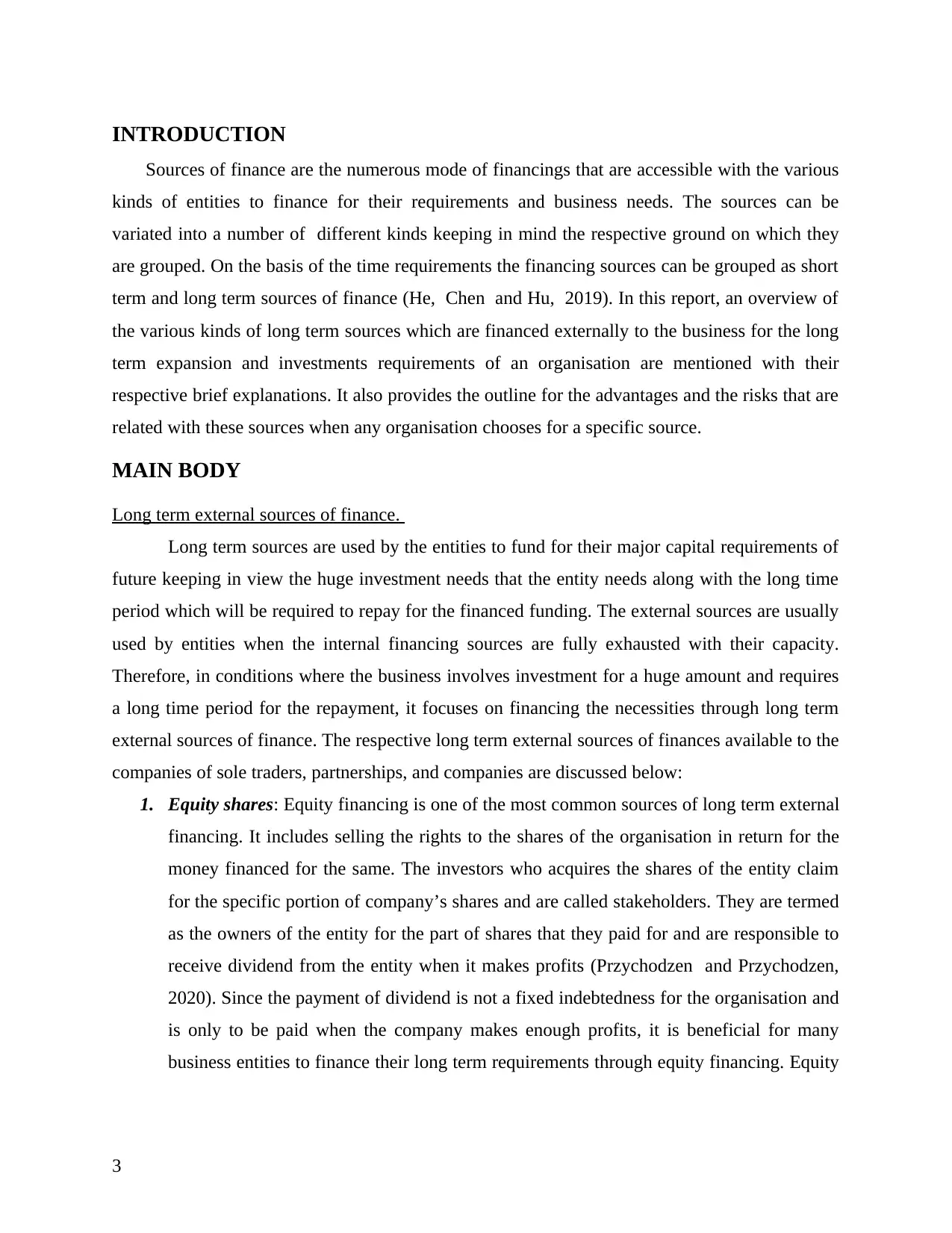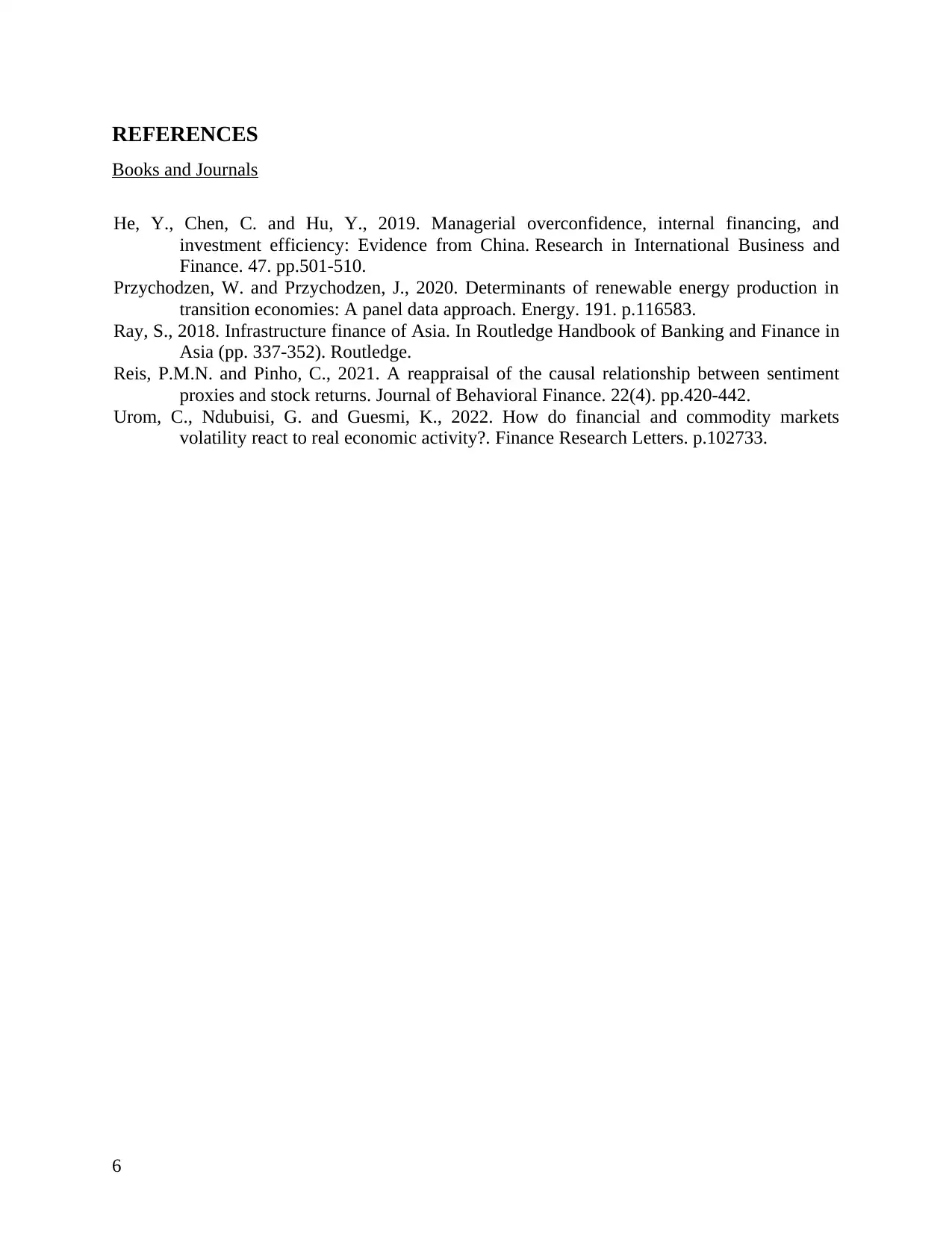Reviewing Long Term External Finance: Sources and Implications
VerifiedAdded on 2023/06/06
|6
|1259
|447
Report
AI Summary
This report provides an overview of long-term external finance sources available to businesses, including sole traders, partnerships, and companies. It discusses various options such as equity shares, debentures, venture capital, and hire purchase, highlighting their respective advantages and risks. Equity financing involves selling company shares, while debentures offer debt financing with fixed interest rates. Venture capital is suitable for early-stage companies, and hire purchase facilitates asset acquisition over time. The report concludes that long-term financing is crucial for expansions, asset procurement, and debt refinancing, offering valuable insights into the financial landscape for different business entities. Desklib provides access to this and other solved assignments for students.

Sources of long term
finance
finance
Paraphrase This Document
Need a fresh take? Get an instant paraphrase of this document with our AI Paraphraser

Contents
INTRODUCTION...........................................................................................................................3
MAIN BODY ..................................................................................................................................3
Long term external sources of finance. .......................................................................................3
CONCLUSION................................................................................................................................5
REFERENCES................................................................................................................................6
INTRODUCTION...........................................................................................................................3
MAIN BODY ..................................................................................................................................3
Long term external sources of finance. .......................................................................................3
CONCLUSION................................................................................................................................5
REFERENCES................................................................................................................................6

INTRODUCTION
Sources of finance are the numerous mode of financings that are accessible with the various
kinds of entities to finance for their requirements and business needs. The sources can be
variated into a number of different kinds keeping in mind the respective ground on which they
are grouped. On the basis of the time requirements the financing sources can be grouped as short
term and long term sources of finance (He, Chen and Hu, 2019). In this report, an overview of
the various kinds of long term sources which are financed externally to the business for the long
term expansion and investments requirements of an organisation are mentioned with their
respective brief explanations. It also provides the outline for the advantages and the risks that are
related with these sources when any organisation chooses for a specific source.
MAIN BODY
Long term external sources of finance.
Long term sources are used by the entities to fund for their major capital requirements of
future keeping in view the huge investment needs that the entity needs along with the long time
period which will be required to repay for the financed funding. The external sources are usually
used by entities when the internal financing sources are fully exhausted with their capacity.
Therefore, in conditions where the business involves investment for a huge amount and requires
a long time period for the repayment, it focuses on financing the necessities through long term
external sources of finance. The respective long term external sources of finances available to the
companies of sole traders, partnerships, and companies are discussed below:
1. Equity shares: Equity financing is one of the most common sources of long term external
financing. It includes selling the rights to the shares of the organisation in return for the
money financed for the same. The investors who acquires the shares of the entity claim
for the specific portion of company’s shares and are called stakeholders. They are termed
as the owners of the entity for the part of shares that they paid for and are responsible to
receive dividend from the entity when it makes profits (Przychodzen and Przychodzen,
2020). Since the payment of dividend is not a fixed indebtedness for the organisation and
is only to be paid when the company makes enough profits, it is beneficial for many
business entities to finance their long term requirements through equity financing. Equity
3
Sources of finance are the numerous mode of financings that are accessible with the various
kinds of entities to finance for their requirements and business needs. The sources can be
variated into a number of different kinds keeping in mind the respective ground on which they
are grouped. On the basis of the time requirements the financing sources can be grouped as short
term and long term sources of finance (He, Chen and Hu, 2019). In this report, an overview of
the various kinds of long term sources which are financed externally to the business for the long
term expansion and investments requirements of an organisation are mentioned with their
respective brief explanations. It also provides the outline for the advantages and the risks that are
related with these sources when any organisation chooses for a specific source.
MAIN BODY
Long term external sources of finance.
Long term sources are used by the entities to fund for their major capital requirements of
future keeping in view the huge investment needs that the entity needs along with the long time
period which will be required to repay for the financed funding. The external sources are usually
used by entities when the internal financing sources are fully exhausted with their capacity.
Therefore, in conditions where the business involves investment for a huge amount and requires
a long time period for the repayment, it focuses on financing the necessities through long term
external sources of finance. The respective long term external sources of finances available to the
companies of sole traders, partnerships, and companies are discussed below:
1. Equity shares: Equity financing is one of the most common sources of long term external
financing. It includes selling the rights to the shares of the organisation in return for the
money financed for the same. The investors who acquires the shares of the entity claim
for the specific portion of company’s shares and are called stakeholders. They are termed
as the owners of the entity for the part of shares that they paid for and are responsible to
receive dividend from the entity when it makes profits (Przychodzen and Przychodzen,
2020). Since the payment of dividend is not a fixed indebtedness for the organisation and
is only to be paid when the company makes enough profits, it is beneficial for many
business entities to finance their long term requirements through equity financing. Equity
3
⊘ This is a preview!⊘
Do you want full access?
Subscribe today to unlock all pages.

Trusted by 1+ million students worldwide

finance does includes dilution of organisations ownership and distribution of voting
rights to the stakeholders.
2. Debentures: Long term financing through debt is grouped as loans and debentures. The
debentures are one of most familiar long term sources of debt financing. Debentures
usually contains a fixed rate of interest and gain maturity at some point of time. The
business selecting to get financing through debentures is liable to pay a fixed interest on
the amount along with the principle amount for which the entity has opted for debentures.
The financing done through debentures in an establishment depicts the entity's debt
capital and is free of any collateral backing unlike the standard loans that are provided by
the financial institutions. The lack of collateral backing is due to the reason that providing
debt financing completely relies upon the goodwill and the credit worthiness of the
establishment obtaining financing through debentures. It is an beneficial financing source
as the interest paid for debentures is a tax deductible expenditure for the organisation and
therefore is advantageous for the company to claim it as an expense against profit. This
makes debentures as a cheap source of financing for the organisations.
3. Venture Capital: Many organisations who are at their establishment stage or in initial
business years, the companies in such conditions can opt for financing their long term
business requirements through venture capital. The individual providing funding through
this source are referred as venture capitalists and before investing in an organisation they
make a detail examination of the entity's financials to examine its financial position
before providing the loan. The loan providence entirely relies upon the financials of the
entity, whether it is satisfactory and safe to invest the loan amount in the entity or not.
The venture capitalists in an enterprise take their exit as soon as they start assembling
reasonable amount of valuation from the entity (Ray,` 2018)
4. Hire purchase: It is one of the most frequently utilized means for the purpose of
financing for the acquisition of various business assets. It works by spreading the whole
value of the asset over a longer period of time. Hence it is an effective source of external
long term funding as it frees a huge amount of capital too be utilized for other purposes in
the business. In hire purchase, the person owing the asset lets any other individual or an
entity which can be termed as hirer, to hire the asset for a specified time period and make
periodic payments for the hire (IReis and Pinho, 2021). These periodic payments made
4
rights to the stakeholders.
2. Debentures: Long term financing through debt is grouped as loans and debentures. The
debentures are one of most familiar long term sources of debt financing. Debentures
usually contains a fixed rate of interest and gain maturity at some point of time. The
business selecting to get financing through debentures is liable to pay a fixed interest on
the amount along with the principle amount for which the entity has opted for debentures.
The financing done through debentures in an establishment depicts the entity's debt
capital and is free of any collateral backing unlike the standard loans that are provided by
the financial institutions. The lack of collateral backing is due to the reason that providing
debt financing completely relies upon the goodwill and the credit worthiness of the
establishment obtaining financing through debentures. It is an beneficial financing source
as the interest paid for debentures is a tax deductible expenditure for the organisation and
therefore is advantageous for the company to claim it as an expense against profit. This
makes debentures as a cheap source of financing for the organisations.
3. Venture Capital: Many organisations who are at their establishment stage or in initial
business years, the companies in such conditions can opt for financing their long term
business requirements through venture capital. The individual providing funding through
this source are referred as venture capitalists and before investing in an organisation they
make a detail examination of the entity's financials to examine its financial position
before providing the loan. The loan providence entirely relies upon the financials of the
entity, whether it is satisfactory and safe to invest the loan amount in the entity or not.
The venture capitalists in an enterprise take their exit as soon as they start assembling
reasonable amount of valuation from the entity (Ray,` 2018)
4. Hire purchase: It is one of the most frequently utilized means for the purpose of
financing for the acquisition of various business assets. It works by spreading the whole
value of the asset over a longer period of time. Hence it is an effective source of external
long term funding as it frees a huge amount of capital too be utilized for other purposes in
the business. In hire purchase, the person owing the asset lets any other individual or an
entity which can be termed as hirer, to hire the asset for a specified time period and make
periodic payments for the hire (IReis and Pinho, 2021). These periodic payments made
4
Paraphrase This Document
Need a fresh take? Get an instant paraphrase of this document with our AI Paraphraser

to the owner of the asset comprise of even the interest payments along with the asset
price which is being paid. This source of financing helps companies to utilize the excess
funds left with them for improving upon their earning performance and capacity (Urom,
Ndubuisi and Guesmi, 2022).
CONCLUSION
From the report prepared above, it can be concluded that long term financing is an
important and available source of financing for all the different entities of sole traders,
partnerships and companies either incorporated or unincorporated. The report has provided
assistance to achieve the major sources of long term external financing that are available for all
the business organisations and what advantages each one provides to the different business
institutions. The major necessities for which the external long term financing is required are
expansions, procurement of new assets, appointment of additional staff or refinancing for
payment of any existing debts.
5
price which is being paid. This source of financing helps companies to utilize the excess
funds left with them for improving upon their earning performance and capacity (Urom,
Ndubuisi and Guesmi, 2022).
CONCLUSION
From the report prepared above, it can be concluded that long term financing is an
important and available source of financing for all the different entities of sole traders,
partnerships and companies either incorporated or unincorporated. The report has provided
assistance to achieve the major sources of long term external financing that are available for all
the business organisations and what advantages each one provides to the different business
institutions. The major necessities for which the external long term financing is required are
expansions, procurement of new assets, appointment of additional staff or refinancing for
payment of any existing debts.
5

REFERENCES
Books and Journals
He, Y., Chen, C. and Hu, Y., 2019. Managerial overconfidence, internal financing, and
investment efficiency: Evidence from China. Research in International Business and
Finance. 47. pp.501-510.
Przychodzen, W. and Przychodzen, J., 2020. Determinants of renewable energy production in
transition economies: A panel data approach. Energy. 191. p.116583.
Ray, S., 2018. Infrastructure finance of Asia. In Routledge Handbook of Banking and Finance in
Asia (pp. 337-352). Routledge.
Reis, P.M.N. and Pinho, C., 2021. A reappraisal of the causal relationship between sentiment
proxies and stock returns. Journal of Behavioral Finance. 22(4). pp.420-442.
Urom, C., Ndubuisi, G. and Guesmi, K., 2022. How do financial and commodity markets
volatility react to real economic activity?. Finance Research Letters. p.102733.
6
Books and Journals
He, Y., Chen, C. and Hu, Y., 2019. Managerial overconfidence, internal financing, and
investment efficiency: Evidence from China. Research in International Business and
Finance. 47. pp.501-510.
Przychodzen, W. and Przychodzen, J., 2020. Determinants of renewable energy production in
transition economies: A panel data approach. Energy. 191. p.116583.
Ray, S., 2018. Infrastructure finance of Asia. In Routledge Handbook of Banking and Finance in
Asia (pp. 337-352). Routledge.
Reis, P.M.N. and Pinho, C., 2021. A reappraisal of the causal relationship between sentiment
proxies and stock returns. Journal of Behavioral Finance. 22(4). pp.420-442.
Urom, C., Ndubuisi, G. and Guesmi, K., 2022. How do financial and commodity markets
volatility react to real economic activity?. Finance Research Letters. p.102733.
6
⊘ This is a preview!⊘
Do you want full access?
Subscribe today to unlock all pages.

Trusted by 1+ million students worldwide
1 out of 6
Related Documents
Your All-in-One AI-Powered Toolkit for Academic Success.
+13062052269
info@desklib.com
Available 24*7 on WhatsApp / Email
![[object Object]](/_next/static/media/star-bottom.7253800d.svg)
Unlock your academic potential
Copyright © 2020–2025 A2Z Services. All Rights Reserved. Developed and managed by ZUCOL.




